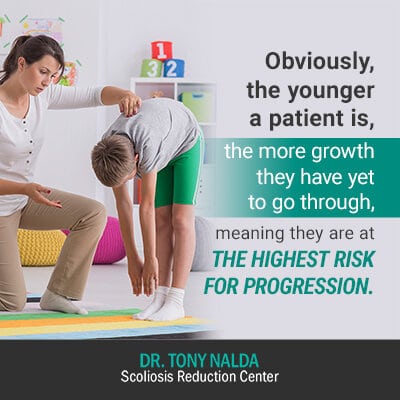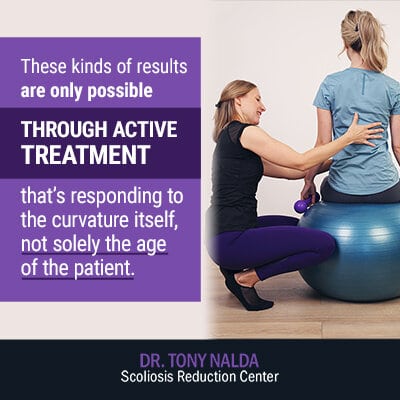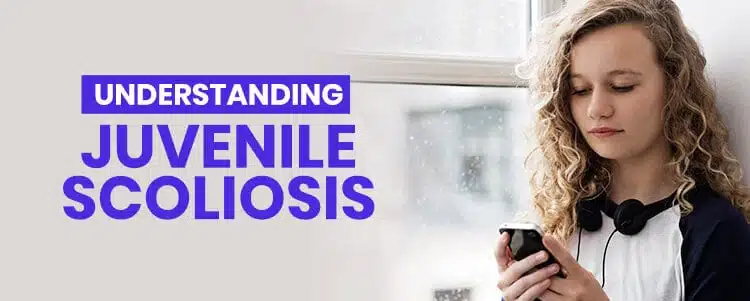While scoliosis is most commonly diagnosed in adolescents, it can develop at any stage of life, including the infantile and juvenile stage. For a patient to be diagnosed with juvenile scoliosis, they would be roughly between the ages of 3 and 10 and have an abnormal spinal curvature that measures more than 10 degrees. When it comes to treating juvenile scoliosis, it’s crucial to understand the options available as the outcome can have life-long consequences.
The most important thing to understand about juvenile scoliosis is that at this stage, treatment can offer the most positive improvements and prognosis. However, to get to those positive results, a proactive treatment path is necessary. Before we get to treatment, let’s first take a look at some of the defining characteristics of juvenile scoliosis.
Defining Juvenile Scoliosis
Juvenile scoliosis is diagnosed in patients between the ages of 3 and 10. This means they have an abnormal spinal curvature that measures at more than 10 degrees.
In the juvenile stage, these patients are past the infant stage and have yet to go through adolescence.
At this stage, juvenile idiopathic scoliosis has a high likelihood of being reduced with active treatment. While there is no official ‘curing’ of scoliosis as it’s classed as an incurable progressive condition, if caught at this early stage, there is the best potential to reduce the scoliosis to the point that it’s no longer officially considered scoliosis.
However, for this potential outcome to become a reality, a specific course of active treatment needs to be followed.
Before we go down the path of treatment options, let’s first take a look at some juvenile scoliosis causes.
Juvenile Scoliosis Causes
A lot of the mystery surrounding scoliosis as a condition involves its causation, and there are many different forms of the condition to consider.
Juvenile Idiopathic Scoliosis
In juvenile ‘idiopathic’ scoliosis, this designation means the condition’s development can’t be tied to one specific cause and is thought to be caused by multiple factors. There are close to 70 different theories on what causes this form of the condition, but they are currently just that: theories.
While these theories have correlations that are found to be true, the cause of juvenile idiopathic scoliosis, like adolescent idiopathic scoliosis, is not fully understood as it’s connected to so many variables.
While this fills a lot of my patients and their families with fear, what I remind them is once scoliosis has developed, although we’d prefer to fully understand the ‘how’ and ‘why’ of its development, not having these answers doesn’t affect treatment-efficacy.
This is the case because what becomes most important to treatment is progression. One thing we know for certain about scoliosis is that growth is the number-one trigger for progression.
If the cause of the condition was also the cause of its progression, there would be a linear progression throughout the patient’s lifetime, but what we see is when growth stops with skeletal maturity, so does progression.
It’s generally accepted that whatever initially caused the curve to develop would likely have resolved itself, if it weren’t for the growth factor affecting progression.
When a patient develops scoliosis at the young age of 3, 4, or 5, the growth that takes place over that child’s lifetime is going to make the curvature progress, and that is a very typical progression line that we know to be true.
This is why growth spurts cause rapid progression, and once growth slows or stops, so does progression.
Underlying Pathologies Known to Cause Juvenile Scoliosis
Generally speaking, the younger the patient is and the larger their curvature is, the greater the likelihood that there is another underlying factor causing the development of juvenile scoliosis.
If a juvenile’s scoliosis isn’t idiopathic, there is an underlying pathology at play, such as an issue in the spinal cord itself, a hemivertebra, a neuromuscular syndrome, or another associative cause.
With the above causes, these patients can still experience successful treatment outcome with my conservative approach; however, there are causes such as tumors under the spine, a cyst within the spinal cord itself (syringomyelia), or a tethered cord that can cause the spine to bend, and these pathologies require a different form of treatment.
Juvenile Scoliosis Symptoms that Indicate Another Pathology
For parents and caregivers of juveniles wanting to know what to look for that would indicate scoliosis is not idiopathic, following are some signs and symptoms to look for.
1) Pain
The largest sign that a scoliosis isn’t idiopathic and is caused by another issue is pain. Kids, juveniles, and adolescents shouldn’t experience pain as part of their scoliosis.
If pain is present, it’s likely not idiopathic scoliosis.
2) Atypical Curve
If a juvenile patient’s X-ray comes back showing their curve bending to the left instead of the right, this would also indicate the presence of another pathology.
A curve that bends to the left is considered an ‘atypical’ scoliosis because typical scoliosis curves bend to the right, away from the heart.
3) Abnormal Neurological Reflexes
If there are any type of abnormal neurological reflexes or diminished reflexes, such as the abdominal reflex, these are signs of a neurological issue.
4) Boys versus Girls
Boys carry a higher incidence of developing scoliosis caused by another pathology than girls. This is likely related to the difference in growth and development patterns between boys and girls.
5) Abnormal Skin Markings
Any type of abnormal skin markings such as lesions, brown marks, cafe-au-laits (spots), or patterns can be indicative of some type of underlying neuromuscular syndrome.
6) Rapid Progression
If a juvenile’s scoliosis is progressing rapidly, say 20 or 30 degrees over a six-month period, this is considered rapid progression and could indicate the presence of another type of condition.
While the majority of cases of juvenile scoliosis are classed as idiopathic, if one or more of the above symptoms are present, these are red flags that something more could be causing the scoliosis.
In order to effectively treat juvenile scoliosis with the best possible likelihood of a successful prognosis, the correct form of the condition has to be diagnosed.
Juvenile Scoliosis Treatment
This is the area of juvenile scoliosis that I enjoy talking about most: treatment. That’s because some of our best treatment results, here at the Scoliosis Reduction Center®, have been with our juvenile patients.
At this young age, treatment is easier because there is a lot of spinal flexibility, and most often, there is a lot of room for improvement to work towards.
I also feel it’s very important to discuss juvenile scoliosis because while treating the condition in this stage can have the most impressive results, it is also a very dangerous stage in terms of progression.

As previously mentioned, one thing we know definitively about scoliosis is that growth affects progression.
Obviously, the younger a patient is, the more growth they have yet to go through, meaning they are at the highest risk for progression.
Basically, at the juvenile stage, a patient’s scoliosis can go in two different directions: rapid progression due to growth, or reduction due to active treatment. This is a pivotal time because the chosen treatment path dictates in which direction the patient’s scoliosis will go.
Treating Idiopathic Juvenile Scoliosis with Conservative Treatment
Once we rule out any underlying pathology and have an official ‘idiopathic’ juvenile scoliosis diagnosis, we want to start our proactive and corrective form of treatment as quickly as possible to stay ahead of the patient’s progression during growth.
What we want to do with our conservative form of treatment is reduce the curvature and hold that reduction; if we can achieve a reduction during this crucial time, the outcome can be fantastic.
There have been many juvenile cases that have come through our Center for treatment, and these cases have come as close to resolving scoliosis as is possible.
By resolving it as much as possible, this means we have reduced the curvature to under 10 degrees so that it’s no longer officially considered scoliosis. In these types of positive outcomes, with minimal stabilization, the reduced curve no longer continues to progress because we’ve eliminated all the risks.
While scoliosis treatment in the juvenile stage can provide the best long-term outcome, the way it’s traditionally treated doesn’t offer this positive result; this is why it’s crucial that parents and caregivers make the best treatment choice for their loved one.
Treating Idiopathic Juvenile Scoliosis with Traditional Treatment
On the traditional orthopedic treatment path, juvenile scoliosis treatment is often held off, instead of initiated as close to the time of diagnosis as possible, as in the conservative approach.
I’ve seen numerous cases where a 4 or 5 year old with scoliosis is diagnosed with a 20- or 25-degree curvature; at this point, at 25 degrees and under, it’s considered mild and under the surgical threshold, so they won’t engage in any active treatment.
The traditional treatment path involves watching and waiting for a mild condition to reach a more serious level. Once that condition has progressed out of the mild and moderate stage into the severe stage, or breaks 45 degrees, spinal-fusion surgery is often recommended as the best treatment option.
The other issue I’ve seen with treating juvenile scoliosis in this traditional approach is that it doesn’t account for how to translate active treatment used on adolescents and adults to small children.
What this means is that they don’t know how to apply rehabilitation, therapy, scoliosis-specific exercises, and other treatment forms to smaller bodies. They also don’t use the option of bracing because they use a Boston Brace, which is a squeezing-style brace, that they don’t want to use on small children.
What this equates to is that in the traditional treatment path, juveniles miss out on these effective treatment options, and the worst course of action, when it comes to scoliosis, is inaction.
Far too often, a number of juvenile cases are left untreated, by traditional orthopedic doctors, until their condition has progressed to that surgical level of 45 degrees.
In the phase between 25 and 45 degrees, while the condition is still considered moderate, in juvenile vs adolescent scoliosis, adolescents are often treated with a brace while juveniles aren’t.
The Cost of Leaving Juvenile Scoliosis Untreated
When juveniles with scoliosis are left untreated because they are thought to be too young to treat, their curvature is left to progress unimpeded.
As juveniles have so much time to grow, they are hitting those surgical levels before even reaching adolescence. With this, comes serious risks and complications associated with performing spinal-fusion surgery on children.
Juveniles haven’t gone through puberty or reached skeletal maturity, and when surgeons start putting rods in their spines, this can stunt the spine’s growth and puts them at risk for multiple complications and needing subsequent surgeries.
Therefore, the risks associated with leaving a juvenile case to progress are significant because, in addition to progression, you also have the potential complications of surgery affecting the growth of the spine.
What I caution parents and caregivers of juveniles with scoliosis about is that although the child may not be able to do the same level or amount of rebab, therapy, and exercises, they can certainly do some, and with the right type of corrective bracing, curves can be substantially reduced to the point where risks are also minimized.
Age Dictating Treatment Rather than the Curve
From this perspective, we can see that when it comes to juvenile scoliosis and the traditional treatment approach, it’s the age of the patient, and not the curvature itself, that’s dictating treatment.
Statistically, we know that once curves break 25 degrees, every single time that patient grows, they have a 66-percent chance of progressing. Once they break 45 degrees, they have a 96-percent chance of progressing.

In a juvenile state, if we actively treat them, reduce the curve, and hold it under 10 degrees early on, we eliminate all those chances of progression, along with the necessity for invasive and costly spinal-fusion surgery.
These kinds of results are only possible through active treatment that’s responding to the curvature itself, not solely the age of the patient.
Juvenile and Infantile Scoliosis
When it comes to juvenile vs infant scoliosis, it’s very interesting that infantile cases are treated more aggressively, when they find 25- and 35-degree curves, than juveniles are.
This aggressive treatment takes the form of casting. Let’s say you have a 1-year-old infant with a 35-degree curve, they are often put in a 24-hour cast for 90 days. Then the cast is replaced by another cast until they see a reduction and the curve is under control.
Now, that same situation can exist, but for a 4 year old, and the treatment choice is often to watch and wait; to me, this represents a big flaw in the traditional treatment approach to juvenile scoliosis.
In these types of cases, it’s not the curve dictating treatment, but the age of the patient. The danger here is watching a juvenile’s condition progress means increasing the chance that they will end up with a rod in their spine and all the potential risks and complications that go along with that.
Conclusion
Here at the Scoliosis Reduction Center®, our conservative approach is to modify our treatment strategy to respond to the patient’s condition at any age.
It’s difficult to understand how juvenile scoliosis cases that carry the most opportunity for resolution tend to be the most neglected and untreated.
The juvenile cases we’ve treated here at the Center have had some of our most impressive results. By modifying our conservative treatment approach to suit smaller bodies, juveniles can benefit from the multiple forms of treatment at our disposal, just as our infant, adolescent, and adult patients do.
Juvenile scoliosis patients can have the best response to treatment, but the parents and caregivers might first have to overcome the indecision and inaction of the traditional approach and seek out active treatment on their own.





